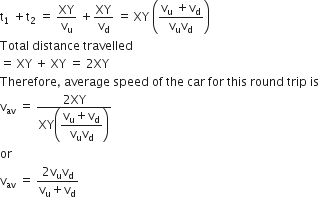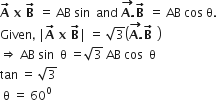A car runs at aconstant speed on a circular track of radius 100 m, taking 62.8 s for every circular lap. The average velocity and average speed for each circular lap respectively is
0, 0
10 m/s, 10m/s
10 m/s, 10m/s
B.
In completing a circular lap, car's displacement is zero.
Average velocity is defined as the ratio of displacement to time taken while the average displacement to time taken while the average speed of a particle in a given interval of time is defined as the ratio of distance travelled to the time taken.
On a circular path in completing one turn, the distance travelled is  while displacement is zero.
while displacement is zero.
Hence, average velocity = 


A car moves from X to Y with a uniform speed vu and returns to Y with a uniform speed vd. The average speed for this round trip is:




A.

The average speed of a body in a given time interval is defined as the ratio of distance travelled to the time taken.
Let t1 and t2 be times taken by the car to go from X and Y and then Y to X respectively.
Then, 
For angles of projection of a projectile at angles (45° - θ) and (45° + θ), the horizontal ranges described by the projectile are in the ratio of
1:1
2:3
1:2
1:2
A.
1:1
For complementary angles of projection, their horizontal ranges will be same.
We know that, horizontal ranges for complementary angles of projection will be same.
The projectiles are projected at angles  and
and  which are complementary to each other i.e., two angles add up to give
which are complementary to each other i.e., two angles add up to give  . Hence, horizontal ranges will be equal. Thus, the required ratio is 1:1.
. Hence, horizontal ranges will be equal. Thus, the required ratio is 1:1.
A particle moving along x- axis has acceleration f, at time t, given f = fo (1-t/T), where fo and T are constants. The particle at t =0 and the instant when f = 0, the particle's velocity (vx) is:
foT
foT2/2
foT2
foT2
D.
foT2
 are two vectors and θ is the angle between them if
are two vectors and θ is the angle between them if  the value of θ is:
the value of θ is:
60o
45o
30o
30o
A.
60o

